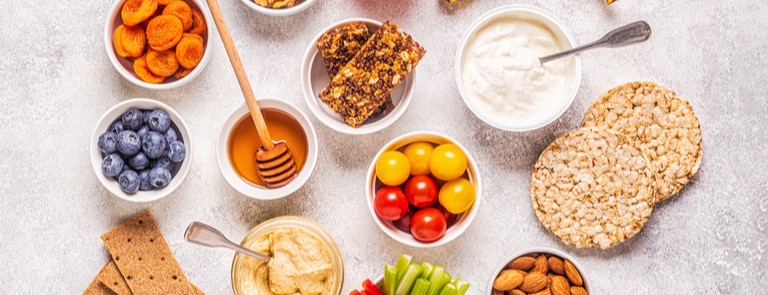15% off €35 or 20% off €45
Your guide to healthy eating

Healthy eating seems simple and complicated at the same time.
We all know what foods are good for us, like fruits, vegetables and wholegrains, as well as what foods should be limited, like cakes, fried food and processed meat.
However, healthy eating isn’t black and white.
Developing a healthy relationship with food, nourishing your body with what it needs and enjoying food you love in moderation is what healthy eating should be the main focus.
Skip to:
What is healthy eating?
Healthy eating is not:
- A weight-loss diet
- A temporary fix
- Something we do to punish ourselves after over-indulging
Healthy eating is:
- Fuelling our bodies in the way they were designed
You’ve probably heard the analogy about healthy food being like putting the correct petrol in your car, ensuring it runs properly.
It’s true – your body is like an (incredibly complex) machine that needs the right fuel in order to perform at its best.
Macronutrients
A healthy diet includes a balance of:
- Protein
- Carbohydrates
- Fat
These are known as macronutrients.
Enough of these, along with enough fibre and fluids, will leave you satisfied.
It’s important to know that you can eat heartily while also eating healthily. You don’t have to eat steamed kale with every meal.
Jacket potatoes, pasta, bread, coffee and even chocolate all have their places in healthy, balanced meals and snacks.
Micronutrients
Along with the macronutrients – protein, carbohydrates and fat – you need micronutrients, too.
These include vitamins and minerals such as:
- Iron
- Cobalt
- Chromium
- Copper
- Iodine
- Manganese
- Selenium
- Zinc
- Vitamin C
- Vitamin A
- Vitamin E
- Vitamin K
- B vitamins, including folate1
Macronutrients are ‘macro’ because they make up most of a healthy diet – your daily calories coming from carbohydrates (including beans, legumes and wholegrains), fats and protein.
Micronutrients are ‘micro’ because we need less of them.
Summary
- Healthy eating is not about losing weight or something to ‘punish’ ourselves with
- It is about fuelling our bodies correctly with a balance of protein, carbohydrates, and fats, fibre, vitamins and minerals
Why is eating healthy important?
There are plenty of reasons to follow a healthy diet.2 Even better, it doesn’t take long before you start to feel some of the benefits:
-
It is an important part of maintaining good health
Eating at least 5 portions of different fruit and vegetables each day and following a balanced diet and healthy lifestyle can reduce the risk of certain diseases.3
-
You’ll have more energy
Certain vitamins and minerals – including B vitamins, iron, and magnesium – have a key role in energy-yielding metabolism.4
Eating a healthy diet ensures you get enough of these nutrients, as well as steady sources of the energy-providing macronutrients like protein, fats and complex carbohydrates – without relying on sugar as a quick energy source.
-
It can help you to manage your weight
Following a healthy and balanced diet can help you to manage and control a healthy weight for your height and body type.
-
Feel more in control
Grabbing fast food instead of waiting a little longer for home-cooked meal or indulging in a late-night snack because you’re craving sugar at bedtime is fine every now and then, but as a regular habit can make you feel out of control.
An understanding of nutrition and the discipline to eat the foods which nourish your body and mind makes you feel like you’re the boss – not cravings.
-
You might feel better as you age
Even if later life seems a long way off, it’s so important to invest in yourself now. Who doesn’t want to stay energetic, fit and well long after you’ve retired?
We might not prioritise calcium in our diets. However, calcium stores in the body are vital to help slow bone loss (osteoporosis) associated with getting older.5
So, if you want to be one of those older people who plays sport, travels the world and keeps up with the grandkids, invest in your diet now.
-
Improve your cooking skills
Being able to produce tasty, nutritious food is an invaluable life skill.
Knowing you can knock up a decent dinner or tasty snack with what’s in the cupboard helps stop you from stressing about mealtimes.
Whether you want saving your family money, eat fresher food, learn about ingredients and flavours or simply not having to rely on convenience foods – there’s no downsides to learning to cook, only benefits.
-
Good example for family
According to CBeebies, kids who cook develop maths and coordination skills and are more likely to be adventurous eaters.6
Cooking also helps teach healthy eating habits and healthy eating facts, as well as the history and geography of different dishes.
Summary
- Eating healthily comes with many benefits, including increased energy, healthy weight management, and keeping well as you age
9 healthy foods to eat in your diet
Remember, there is no such thing as ‘best’ or ‘healthiest food’.
Balance is the key here, and your main goal should be to incorporate a wide variety of healthy foods in your diet, because they provide us with different combination of nutrients.
Here are some nutrient-packed foods to eat every day:
-
Red peppers
The intense red colour of these fruits gives a clue as to how much antioxidant they contain.
There are around 23 calories in one small red pepper, while boasting an incredible 157% of your daily vitamin C and nearly half your daily requirement of vitamin A.7
-
Spinach
It might be hard to get too excited about spinach, but if you’re looking for healthy foods then you should make room on your plate for spinach.
Alongside vitamins K, A, C and B, spinach also contains phytonutrients such as chlorophyll.8
- Raspberries
These jewel-like fruits taste sour or sweet depending on when they’re harvested.
With only 25 calories per 100g, raspberries contain vitamin C and antioxidants. They also contain vitamin A, vitamin B6, calcium and zinc.9
Buying them frozen is an inexpensive option. Throw them in porridge as it's being cooked – or use in overnight oats, smoothies or chia bowls for a cooling breakfast.
-
Kiwi
Containing more vitamin C than oranges, kiwi also contains the antioxidant vitamin E. Kiwi fruit also contains vitamin K, which contributes to the maintenance of normal bones.10
-
Avocado
High in monounsaturated fat and vitamin E.
They also contain good amounts of potassium (more than bananas), iron, copper, and folate.11
-
Sweet potato
Containing fibre, calcium and selenium as well as vitamins B and C.
Sweet potatoes also contain beta-carotene, which we convert to vitamin A. Sweet potato peel contain antioxidants, so scrub, don’t peel!12
-
Broccoli
Forget the flabby, boiled broccoli of your school dinners.
Blanched, sautéed, grilled or roasted, broccoli is a great carrier for herbs and spices in a range of dishes, including Italian and East Asian cuisine.
With just 2 ‘trees’ counting as 1 portion of vegetables, broccoli also contains iron, potassium, calcium, selenium and magnesium and vitamins A, C, E and K.13
-
Chia seeds
These tiny seeds contain protein, fibre and omega-3 fats. Further, when liquid is added, chia seeds form a gel-like substance.14
Perfect sprinkled in porridge or overnight oats.
-
Quinoa
It contains fibre and minerals calcium, magnesium and manganese.15
Technically a seed, quinoa behaves like a grain and replaces pasta, rice, couscous and bulgur in countless recipes.
Summary
- There are lots of heathy foods to choose from, including fresh fruits, vegetables, nuts, seeds, and wholegrains like quinoa
5 healthier food swaps
Finding alternatives to your favourites isn’t just about finding a lower-calorie option.
The amounts of fibre, protein, vitamins and minerals in your food should also play a role in our choices – not to mention whether it will actually satisfy your craving!
The psychological side of food is one that you can’t ignore when trying to change your diet for the better.
This is why we’d never suggest steamed broccoli when you get a chocolate craving.
We also crave certain textures and sensations when we eat, for example chomping brittle, noisy crisps make us feel better than eating soft ones.16,17
-
Swap sweets for dried fruit
Dried fruit can be just as sweet as candy, but dried fruit also comes with minerals like iron and calcium.
-
Swap crisps for popcorn
Try popcorn or seaweed sheets to recreate that satisfying crunch.
-
Swap biscuits for oat bars
Biscuits usually don’t contain much protein or fibre, meaning it’s easy to gobble down half a packet without feeling full. Make your own healthier alternative with that sweet chewy texture you love.
-
Swap chocolate muffins for mug cakes
Make a gooey, indulgent mug cake using a scoop of chocolate-flavoured whey protein powder, an egg and a splash of your choice of milk.
Mix together and microwave the mug for 60 seconds.
-
Swap ice cream for frozen yoghurt
Cold, creamy and the flavour you love. Frozen yoghurt ticks all the boxes when it comes to ice cream cravings.
Read on to find out more about the nutrition of each food swap.18
| Calories | Fat | Sugar | Protein | Carbohydrates | Vitamins & minerals | |
|---|---|---|---|---|---|---|
| Milk chocolate (100g) | 556kcal | 32g | 48g | 6g | 60g | 100g contains 10% of daily iron |
| Dried figs (100g)19 | 249kcal | 0.9g | 47.9g | 3.3g | 63.9g | Contains; calcium, iron, magnesium, manganese and copper |
| Salted crisps (30g bag)20 | 249kcal | 9g | 0.1g | 1.7g | 15.5g | Small amounts of vitamin C and vitamin B6 |
| Popcorn (30g)21 | 116kcal | 1.4g | 0.3g | 3.9g | 23.3g | Small amounts of iron and potassium |
| Biscuits (3 x chocolate digestives)22 | 252kcal | 12.3g | 15g | 3.6g | 33.9g |
Traces |
| Oat bar x 1 | 276kcal | 13.4g | 15.5g | 18.6g | 29g | Magnesium, zinc, selenium, iron, manganese, vitamins A, B, C and E |
| Chocolate muffin x 123 | 443kcal | 20g | 28g | 7.1g | 63g | 16% of your daily iron |
| Chocolate protein mug cake x 124 | 218kcal | 7g | 1.6g | 30g | 1.6g | Contains; calcium, potassium and protein |
| Ice cream (150g)25 | 215kcal | 7.7g | 24.6g | 3.1g | 33.8g | Contains a little calcium and vitamin A |
| Frozen yoghurt26 | 127kcal | 3.6g | 20g | 3g | 22g | Contains a little vitamin A, calcium and iron |
Healthier snack swaps to improve your diet
Healthier snack swaps to improve your diet
These ten snack swap ideas could make a big difference to your diet.


8 healthy eating tips
It can take just over two months to form a habit.
That may seem like a long time, but the benefits can be well worth the investment.
Below are a few tips that you can easily follow to start eating healthier, including some bad eating habits to avoid.
Remember, to stay on track, it can be a good idea to keep a diary or set yourself challenges.19
-
Snack better
Crisps and chocolate are a quick way to tip your fat intake over the edge.
If, like most of us, you’re fond of a snack, have a packet of nuts or grains to hand.
Alternatively, satisfy your hunger with guilt-free low-fat treats like carrots and hummus or some of the options in our healthy food and drink section.20
-
Eat smaller meals often
One of the best habits you can take up is to eat smaller portions more often instead of three big meals.
If you can, prepare your meals in advance to get a good supply of nutrients throughout the day. Eating like this can keep you feel fuller for longer and speed up your metabolism.21
-
Cut down on saturated fat
Everyone needs a bit of fat in their diet, but too much of the saturated kind can raise your cholesterol and lead to heart disease.
Look at what you’re eating and make simple changes like swapping butter for olive or sunflower spread.
-
Drink more water
As well as preventing dehydration, getting six to eight glasses of water in a day can flush the toxins in your body and improve your digestion.
If you often forget to drink water, buy a reusable bottle and keep it nearby.22
-
Stop skipping breakfast
Eating breakfast can kickstart your body’s calorie-burning cycle (your metabolism).
If you find the same breakfast cereals boring, explore other high fibre and low-fat alternatives like rye bread or overnight oats with fruit.23
Handpicked content: How to build a balanced breakfast
-
Cook your takeaways
Everyone loves a takeaway, but have you ever thought about cooking your own healthy fast food options?
There are delicious recipes online for all your favourite cuisines. What’s more, making your takeaway means you can regulate your salt and sugar intake better.
-
Load up on fruit and vegetables
Your five-a-day should form the basis of any healthy eating habit.
Are you struggling to get yours in? Try chopping bananas on your porridge or using snack times as an excuse to try more exotic fruits like mango and pineapple.
-
Sticking to your habits
The key to healthy eating is balance. Overeat of the same thing, and you’ll be missing out on essential nutrients and vitamins.
At the same time, it’s ok to have a treat if you’re getting enough of the good stuff. Why not mix up your shopping list with delicious foods you’ve never tried before?
If you’re stuck for inspiration, check out our food and drink page for a range of healthy ingredients.
Summary
- Healthy eating tips like improving your snacking habits, cutting down on saturated fat, and cooking your takeaways can help make it easier to sustain long term
The final say
- Healthy eating is not about losing weight or something to ‘punish’ ourselves with
- It is about fuelling our bodies correctly with a balance of protein, carbohydrates, and fats, vitamins and minerals
- Eating healthily comes with many benefits, including increased energy, healthy weight management, and keeping well as you age
- There are lots of heathy foods to choose from, including fresh fruits, vegetables, nuts, seeds, and wholegrains like quinoa
- Swapping foods like sweets and crisps for healthier alternatives like dried fruit and popcorn can help you eat more healthily
- Healthy eating tips like improving your snacking habits, cutting down on saturated fat, and cooking your takeaways can help make it easier to sustain long term
The advice in this article is for information only and should not replace medical care. Please check with your GP or healthcare professional before trying any supplements, treatments or remedies. Food supplements must not be used as a substitute for a varied and balanced diet and a healthy lifestyle.
Last updated: 27 January 2022
- https://www.nhs.uk/conditions/vitamins-and-minerals/
- https://www.nhs.uk/conditions/vitamins-and-minerals/
- https://www.nhs.uk/live-well/eat-well/
- https://www.ncbi.nlm.nih.gov/pmc/articles/PMC7019700/
- https://www.nhsinform.scot/healthy-living/preventing-falls/keeping-well/looking-after-your-bones
- https://www.bbc.co.uk/cbeebies/grownups/cooking-and-baking-with-toddlers
- https://nutritiondata.self.com/facts/vegetables-and-vegetable-products/2896/2
- http://www.whfoods.com/genpage.php?tname=george&dbid=431
- https://www.nutritionvalue.org/Raspberries%2C_raw_nutritional_value.html
- https://www.nutritionix.com/food/kiwi
- https://www.ncbi.nlm.nih.gov/pmc/articles/PMC3664913/
- https://www.livescience.com/46016-sweet-potato-nutrition.html
- https://www.livescience.com/45408-broccoli-nutrition.html
- https://www.sciencedirect.com/science/article/pii/S1756464620302504
- https://www.livescience.com/50400-quinoa-nutrition-facts.html
- https://www.mentalfloss.com/article/531186/science-behind-why-we-crave-loud-and-crunchy-foods
- https://fdc.nal.usda.gov/
- https://fdc.nal.usda.gov/
- https://jamesclear.com/new-habit
- https://www.nhs.uk/live-well/eat-well/eight-tips-for-healthy-eating/
- https://health.clevelandclinic.org/how-small-frequent-meals-can-help-athletes-keep-energy-high/
- https://www.medicalnewstoday.com/articles/290814#benefits
- https://www.rush.edu/health-wellness/discover-health/why-you-should-eat-breakfast



